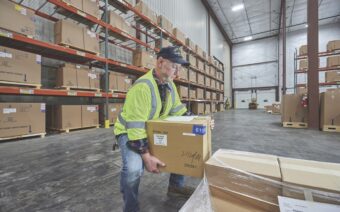
March 10, 2025
In today’s competitive business landscape, keeping employees happy, healthy and productive is crucial for any company’s success.
Many organizations invest substantial resources in improving workplace wellness, hoping to boost employee health and reduce injuries.
But despite these efforts, the results often fall short.
Why?
Many so-called “best practices” and workplace wellness fads are outdated and not as effective as they seem.
At Paramount Performance Physical Therapy and Performance Training, we focus on doing things differently – thinking outside the box in regard to workplace wellness.
Below are a few of the biggest workplace wellness and safety myths we see from employers and HR professionals, along with some potential solutions to help take businesses to the next level in employee happiness, health and culture.
Myth: ‘Addressing ergonomics is the best way to reduce workplace injuries’
Ideal ergonomics are important, but they’re not the whole picture.
When you focus on ergonomic solutions as your primary injury prevention strategy, you’re creating a one-size-fits-all fix that may seem great in theory – but it only addresses the environmental problem, not the individual.
This can result in significant investment in a solution that looks good on paper but may actually create even worse issues for employees.
Potential solution
Address the individual’s issues first, then the equipment and setup.
If an employee’s physical limitations – such as underlying musculoskeletal conditions or poor movement patterns – aren’t addressed, adjusting their workspace won’t fix the root problem.
The goal should be to improve the individual’s physical movement health while tailoring the workspace to their specific needs, adjusting ergonomics as they progress.
Myth: ‘Health benefits are the best option to make employees healthier’
Health benefits only work if employees use them – and many don’t due to barriers like time, cost and a confusing healthcare system.
Additionally, some industrial employees are tough, downplay their ailments and are hesitant to reach out to medical providers.
They often don’t acknowledge minor discomfort until it becomes a full-blown injury, meaning those benefits remain unused while employees continue to struggle.
Potential solution
Provide an on-site physical therapist who can eliminate these barriers by building real relationships with employees and addressing minor aches and pains before they become major issues.
This strategy focuses on prevention, early intervention and education while giving employees the trust and guidance they need to advocate for themselves and better utilize their healthcare benefits.
Myth: ‘Standing desks will solve everything’
Standing desks are trending right now, and for good reason.
Encouraging employees to stand and move around is beneficial, and a standing desk can certainly help reduce sitting time.
However, they’re not the magic bullet they’re often made out to be, and they come with their own set of challenges.
Many employees lack the endurance and muscle activation needed to stand properly for long periods.
This can lead to poor posture, improper weight shifting and other habits that may result in new injuries and discomfort.
Potential solution
A balanced approach that incorporates purposeful movement throughout the day is a better solution.
Just five minutes of walking and simple stretches can improve blood flow, relieve tension and enhance muscle activation – leading to fewer physical issues and better mental functioning.
For employees using standing desks, ensure they split their time evenly between sitting and standing while also being educated on posture and movement habits to prevent potential problems.
Myth: ‘A nurse or triage hotline is the best way to handle workplace, non-workplace injuries’
These resources can be useful for first-aid situations like cuts or eye injuries, but they fall short when dealing with orthopedic issues, such as back pain or joint injuries.
Hotline staff are trained to address a broad range of issues, which can be helpful for basic wellness concerns, but they often provide vague recommendations when it comes to musculoskeletal injuries.
This typically results in continued pain, additional costs and frustration for the employee.
Potential solution
Have a physical therapist on call who specializes in these types of injuries.
With their expertise in diagnosing and treating musculoskeletal conditions, they can provide immediate, accurate advice, create better care plans and help employees navigate doctors and benefits – ultimately reducing unnecessary medical visits and procedures.
Myth: ‘Step challenges, workplace competitions boost employee engagement, health’
These programs tend to attract the healthiest employees – the ones who don’t necessarily need extra support.
Meanwhile, employees who would benefit the most often feel intimidated or excluded.
Traditional wellness challenges are typically one-size-fits-all, competition-based and lack personalization, making them ineffective for many employees.
Potential solution
Instead, offer personalized programs and resources that meet employees where they are.
Having an on-site physical therapist is, once again, an excellent way to provide individualized support and create tailored programs that employees can actually stick with.
You can still include a competition component, but by grouping employees based on their needs and fitness levels, you create a more inclusive, supportive and effective approach.
This approach can help ensure every individual’s unique needs are addressed while also fostering communication, accountability and engagement across different teams and locations.
The bottom line
If you’re investing in workplace wellness, make sure your efforts are actually making a difference.
Many traditional strategies are outdated, ineffective or even counterproductive.
By shifting the focus to individualized care, purposeful movement and proactive intervention, businesses can create a work environment where employees feel valued, supported and genuinely healthier.
Employee health and well-being shouldn’t be a trend, but a long-term investment in your workforce’s future.
 At the forefront of the foundry industry’s future
At the forefront of the foundry industry’s future New Mid-State manufacturing, engineering technology center result of community partnership
New Mid-State manufacturing, engineering technology center result of community partnership








